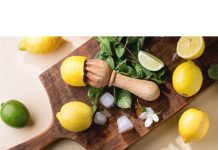Citrus juicers are a beloved kitchen gadget for many, effortlessly transforming tangy oranges and zesty lemons into refreshing beverages. However, like any piece of equipment, they require a little TLC to ensure their longevity. In this article, we’ll share some practical tips and tricks that will help you extend the life of your citrus juicer, so you can continue to enjoy freshly squeezed juices for years to come. Say goodbye to prematurely worn-out juicers – we’ve got you covered!
Review contents
Regular Cleaning
Wash After Every Use
To ensure the longevity of your citrus juicer, it is important to clean it thoroughly after each use. This practice not only maintains the cleanliness of your juicer but also prevents the buildup of pulp, seeds, and juice residue, which can affect its performance over time. By washing the juicer immediately after use, you can easily remove any leftover fruit particles and prevent them from hardening or clogging the machine. Simply disassemble the juicer and rinse each component under warm running water, using a brush or sponge to remove any stubborn residue.
Clean Immediately After Juicing
In addition to washing your citrus juicer after every use, it is crucial to clean it immediately after juicing. This is especially important if you have been juicing different citrus fruits or varieties, as the acidic nature of the juice can cause corrosion if left unattended. By cleaning the juicer promptly, you can prevent the citrus juice from drying on the surfaces and avoid potential damage to the juicer’s internal parts.
Remove Pulp and Seeds
While some people may enjoy the pulp and seeds in their citrus juice, allowing them to accumulate in your juicer can lead to performance issues and decrease its lifespan. It is recommended to remove the pulp and seeds from the juicer after each use. This can be done by using a spoon or spatula to scrape out any remaining pulp from the juicing mechanism and discarding the seeds in a proper waste container. By keeping your juicer free from excess pulp and seeds, you can ensure its smooth operation and prevent any blockages or malfunctions.
Sanitize the Juicer
Sanitizing your citrus juicer regularly is essential for maintaining its cleanliness and preventing the growth of bacteria or mold. After cleaning the juicer with warm soapy water, it is advisable to use a food-safe sanitizer or bleach solution to disinfect the components. Be sure to thoroughly rinse the juicer after sanitizing to remove any residual cleaning agents. This simple step will help you avoid any potential health risks and keep your citrus juicer in pristine condition.
Proper Handling
Handle the Juicer with Care
When operating a citrus juicer, it is important to handle it with care to prevent any accidental damage. Avoid applying excessive force or pressure when inserting citrus fruits into the juicer, as it can strain the motor, blades, or other delicate parts. Treat your juicer gently and ensure a smooth operation by using a controlled and steady motion while juicing. By handling your citrus juicer with care, you can avoid unnecessary wear and tear, prolong its lifespan, and enjoy its benefits for a longer period.
Avoid Overloading
As tempting as it may be to juice large quantities of citrus fruits at once, overloading your juicer can put undue stress on its motor and components. Always consult the juicer’s user manual and adhere to the recommended fruit capacity guidelines. Overloading the juicer can lead to reduced efficiency, motor burnout, or even permanent damage. By following the manufacturer’s instructions and juicing within the recommended limits, you can ensure optimal performance and extend the life of your citrus juicer.
Use the Correct Juicing Technique
Using the correct juicing technique is crucial for both the quality of your juice and the longevity of your juicer. Start by choosing fresh, ripe citrus fruits and cutting them into smaller pieces to allow for easier juicing. Place the fruit on the juicer’s reamer or cone, applying gentle pressure to extract the juice without straining the motor. Avoid forcefully pushing down on the fruit or twisting it vigorously, as it can place excessive strain on the juicer’s components. By using the correct juicing technique, you can maximize the juice yield and minimize the risk of damaging your citrus juicer.
Maintenance and Lubrication
Inspect the Juicer Regularly
Regularly inspecting your citrus juicer is an essential part of its maintenance routine. Take the time to visually inspect all the components, including the motor, blades, and juicing mechanism, for any signs of wear, damage, or loose fittings. Check for cracks, chips, or corrosion, as these can compromise the juicer’s performance and even pose safety hazards. By proactively identifying any issues, you can address them promptly, either by repairing or replacing the affected parts and ensuring the continued functionality of your citrus juicer.
Replace Worn Parts
Over time, certain components of your citrus juicer may wear out or become less efficient. It is important to replace any worn or damaged parts to maintain the optimal functioning of your juicer. Consult the manufacturer’s guidelines or contact customer service to identify the specific replacement parts needed for your model. Common parts that may require replacement include blades, strainers, reamers, and pulp containers. By replacing these worn parts, you can improve the juicer’s performance, prolong its lifespan, and continue to enjoy freshly squeezed citrus juice.
Lubricate Moving Parts
To ensure smooth operation and reduce friction between moving parts, it is recommended to lubricate your citrus juicer periodically. Consult the user manual or manufacturer’s instructions for specific lubrication guidelines tailored to your juicer model. Use food-grade lubricants or oils suitable for juicing equipment, applying them sparingly to the designated areas. Lubricating the moving parts of your juicer helps minimize wear and tear, reduces the chance of the motor overheating, and extends the overall lifespan of your citrus juicer.
Storing the Citrus Juicer
Store in a Dry Place
Proper storage of your citrus juicer is crucial to protect it from moisture, which can lead to rust and corrosion. After thoroughly cleaning and drying all the components, store your juicer in a cool, dry place. Avoid storing it near sinks, dishwashers, or any other sources of water or steam. By keeping your citrus juicer in a dry environment, you can prevent potential damage and ensure its longevity.
Protect from Humidity
Humidity can be detrimental to the lifespan and performance of your citrus juicer. If you live in a humid climate or are storing your juicer in an area prone to moisture, consider using moisture-absorbing packets or silica gel packs to help reduce humidity levels. These can be placed inside the juicer or in the storage location to prevent the buildup of moisture and protect your juicer from potential damage.
Avoid Extreme Temperatures
Extreme temperatures can also impact the performance and durability of your citrus juicer. Avoid exposing your juicer to direct sunlight or storing it in areas with extreme heat or cold. High temperatures can cause the plastic components to warp or melt, while low temperatures may affect the functionality of the motor or other internal parts. By storing your citrus juicer in a location with a moderate and consistent temperature, you can ensure its longevity and reliable performance.
Choosing High-Quality Citrus Juicer
Read Reviews and Ratings
Before purchasing a citrus juicer, it is advisable to read reviews and ratings from other customers. Online platforms, such as e-commerce websites or dedicated juicer review sites, often provide valuable insights into the performance, reliability, and durability of different citrus juicer models. Consider the overall satisfaction of previous buyers, taking note of any recurring issues or complaints. By gathering this information, you can make an informed decision and choose a high-quality citrus juicer that is likely to have a longer lifespan.
Consider the Material and Construction
When selecting a citrus juicer, pay attention to the materials and construction used in its manufacturing. Opt for juicers made from durable and high-quality materials, such as stainless steel or BPA-free plastic. Stainless steel components are generally more resistant to corrosion and wear, while BPA-free plastic ensures a safer juicing experience. Additionally, check for solid construction and sturdy assembly, as this contributes to the overall durability and longevity of your citrus juicer.
Check for Warranty
A warranty is an indicator of a manufacturer’s confidence in their product and can provide you with additional peace of mind. Look for citrus juicers that come with a warranty, preferably one that covers a reasonable period of time. This ensures that, in case of any manufacturing defects or unexpected issues, you can easily have your juicer repaired or replaced without incurring additional costs. Checking for a warranty not only protects your investment but also serves as an assurance of the citrus juicer’s overall quality and longevity.
Avoiding Excessive Strain
Prevent Overworking the Motor
To extend the life of your citrus juicer’s motor, it is crucial to prevent overworking it. Give your juicer regular breaks during juicing sessions, especially when juicing large quantities of citrus fruits. Continuous usage without allowing the motor to rest can cause overheating, which may lead to motor burnout or failure. Follow the manufacturer’s guidelines regarding recommended juicing durations and rest periods to ensure the longevity of your citrus juicer’s motor.
Allow the Juicer to Rest
Similarly, after finishing a juicing session, allow your citrus juicer to rest before using it again. This break gives the motor and other components time to cool down and recover from the previous operation. Avoid immediately starting another juicing session or disassembling the juicer while it is still warm. Allowing your citrus juicer to rest not only protects it from potential damage but also helps maintain its overall performance and efficiency over time.
Using the Citrus Juicer Properly
Cut Citrus Fruits into Smaller Pieces
To optimize the juicing process and reduce strain on your citrus juicer, it is advisable to cut citrus fruits into smaller pieces before juicing. This allows for easier extraction of juice and prevents the motor from overexerting itself. By dividing the citrus fruits into manageable pieces, you ensure that the juicer can extract the maximum amount of juice without unnecessary strain. This simple practice can significantly extend the life of your citrus juicer and contribute to a smoother juicing experience.
Alternate Between Hard and Soft Fruits
When juicing a variety of citrus fruits, it is beneficial to alternate between hard and soft fruits to prevent excessive strain on the juicer’s motor. Hard fruits, such as lemons or limes, require more pressure to extract juice, while softer fruits, like oranges or grapefruits, yield juice more easily. By alternating between hard and soft fruits, you give the motor a chance to adjust its workload and reduce the risk of overheating or motor burnout. This balanced juicing technique helps maintain the efficiency of your citrus juicer and prolong its lifespan.
Avoiding Certain Fruits
Avoid Overly Ripe or Soft Fruits
While it may be tempting to use all your citrus fruits, including overly ripe or soft ones, it is best to avoid juicing these types of fruits. Overripe or excessively soft fruits contain higher levels of water and are more likely to produce diluted or watery juice. Additionally, the juicer may struggle to extract the juice efficiently from these fruits, leading to increased strain on the motor and components. Therefore, it is advisable to choose firm and ripe citrus fruits for optimal juicing results and to preserve the longevity of your citrus juicer.
Avoid Fruits with Large Seeds or Pits
Citrus fruits with large seeds or pits can pose a challenge for your citrus juicer and potentially damage its internal parts. When juicing fruits like grapefruits or pomelos, which have large seeds or pits, it is recommended to remove them before juicing. This can be done by manually scooping out the seeds or pits with a spoon or knife. By avoiding fruits with large seeds or pits, you can prevent any potential damage to the juicer’s blades, reamers, or strainers, and ensure the prolonged functionality of your citrus juicer.
Avoiding Citrus Peel
Peel Citrus Fruits before Juicing
To maintain the quality and prolong the lifespan of your citrus juicer, it is crucial to peel the citrus fruits before juicing them. The peel contains oils and compounds that can affect the taste of the juice and potentially clog the juicer’s components. By removing the peel, you ensure that only the fresh, juicy pulp is extracted, resulting in a purer and more enjoyable citrus juice. Additionally, avoiding the citrus peel minimizes the risk of any potential blockages or damage to your citrus juicer.
Remove Excess Pith
Pith refers to the white, spongy layer beneath the citrus peel, which can affect the quality of the juice and strain your citrus juicer. It is advisable to remove any excess pith before juicing the citrus fruits. This can be done by carefully using a knife or peeler to scrape off the pith from the fruit’s surface. By removing excess pith, you ensure a smoother juicing process, prevent potential clogging, and extend the overall lifespan of your citrus juicer.
Regularly Sharpening Blades
Check Blade Sharpness
The blades of your citrus juicer play a crucial role in extracting juice efficiently and effectively. Over time, these blades can become dull or blunt, impacting the juicer’s performance and lifespan. Regularly checking the blade sharpness is essential to ensure optimal juicing results. Inspect the blades for any signs of wear or corrosion. If they appear dull or damaged, it is time to sharpen or replace them. Keeping the blades sharp enhances the juicer’s efficiency, reduces strain on the motor, and extends the overall lifespan of your citrus juicer.
Sharpen When Needed
When your citrus juicer’s blades show signs of dullness or damage, it is important to sharpen them promptly. Consult the manufacturer’s instructions or contact customer service for guidance on how to sharpen the blades specific to your juicer model. Using the appropriate sharpening tools, carefully sharpen the blades to restore their sharpness and functionality. Regularly sharpening the blades ensures optimal juicing performance, minimizes motor strain, and extends the longevity of your citrus juicer.
By following these comprehensive tips and guidelines, you can extend the life of your citrus juicer and continue to enjoy fresh, flavorful citrus juice for years to come. Regular cleaning, proper handling, maintenance, and correct usage techniques are the pillars of maximizing the lifespan of your citrus juicer. Additionally, selecting a high-quality juicer and avoiding excessive strain or juicing certain fruits can further contribute to your juicer’s longevity. Investing time and effort in caring for your citrus juicer will not only save you money in the long run but also ensure a reliable and efficient juicing experience every time. So grab your favorite citrus fruits, juice away, and savor the natural goodness knowing that your citrus juicer is well taken care of. Cheers to a healthier lifestyle and a longer life for your citrus juicer!
































